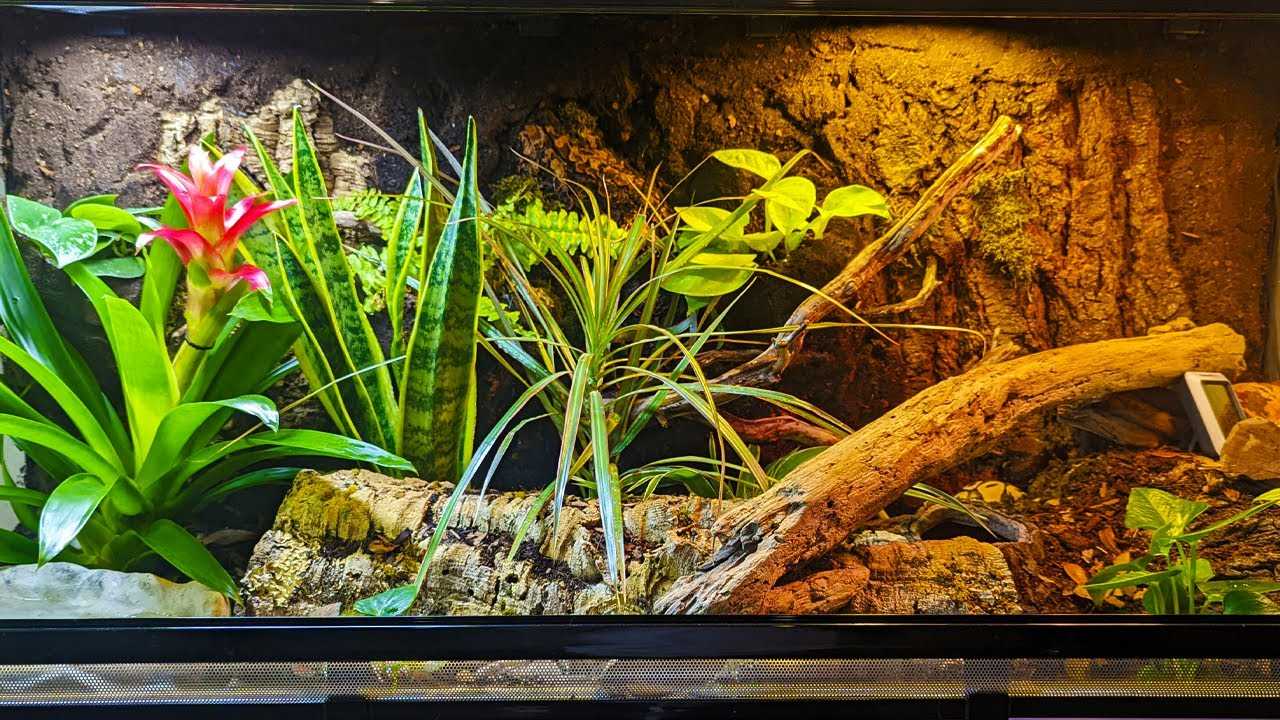
A bioactive setup involves creating a self-sustaining ecosystem within the terrarium. This includes using live plants, natural substrate, and beneficial microorganisms to create a healthy and stimulating environment for your ball python. The presence of plants not only adds aesthetic value to the enclosure, but also helps maintain adequate humidity levels and provides hiding places for the snake.
Choosing the right substrate is also crucial for the well-being of your ball python. A bioactive substrate, such as a mixture of organic potting soil, sphagnum moss, and coconut coir, not only provides a naturalistic look, but also helps maintain proper humidity levels and promotes the growth of beneficial soil-dwelling organisms. Such organisms can assist in breaking down waste products and maintaining a healthy environment for your ball python.
What is a Ball Python?
These snakes get their name from their defensive behavior of curling into a tight ball when they feel threatened. This natural defense mechanism gives them a unique appearance and adds to their appeal as pets.
Bioactive Care for Ball Pythons
Bioactive care for ball pythons involves creating a natural and self-sustaining environment in their terrarium. This type of care focuses on mimicking the snake’s natural habitat and providing them with a bioactive substrate, live plants, and the right lighting and temperature conditions.
In addition to the substrate, live plants are also an important component of a bioactive enclosure for ball pythons. These plants not only add aesthetic value to the terrarium but also provide hiding spots and contribute to the overall environmental enrichment of the snake.
Feeding ball pythons in a bioactive enclosure is slightly different from conventional feeding methods. Live or frozen-thawed prey items are introduced into the terrarium, allowing the snake to exhibit natural hunting behaviors. This provides mental and physical stimulation for the snake, promoting a more natural and active lifestyle.
Bioactive care for ball pythons offers numerous benefits, including improved physical and mental well-being, reduced stress levels, and a more aesthetically pleasing and naturalistic habitat. It requires more attention to detail and maintenance compared to traditional setups, but the rewards are worth the effort.
Why Choose Bioactive Care for Ball Pythons?
Bioactive care for ball pythons involves creating a naturalistic and self-sustaining enclosure that mimics their natural habitat. This approach aims to recreate a mini-ecosystem within the enclosure by incorporating live plants, invertebrates, and a diverse substrate.
So, why choose bioactive care for your ball python?
1. Natural Environment: Bioactive setups allow ball pythons to experience a more realistic and enriching environment. The inclusion of live plants provides hiding spots, climbing opportunities, and a sense of security for the snakes. This can help reduce stress and promote natural behaviors.
2. Physical and Mental Stimulation: In a bioactive enclosure, ball pythons can engage in natural behaviors such as exploring, climbing, and burrowing. This helps keep them physically active and mentally stimulated, which is essential for their overall well-being.
3. Improved Air Quality: The incorporation of live plants not only adds to the aesthetic appeal of the enclosure but also helps improve air quality. Plants aid in the removal of toxins and help maintain proper oxygen levels, creating a healthier living environment for your ball python.
4. Natural Feeding Opportunities: Bioactive enclosures also provide opportunities for natural feeding behaviors. The inclusion of invertebrates, such as springtails and isopods, helps break down waste and uneaten food, preventing the buildup of bacteria and reducing the risk of infections.
5. Reduced Cleaning Frequency: One of the major advantages of bioactive care is the reduced need for frequent enclosure cleaning. The combination of a diverse substrate and the activity of bioactive organisms, such as isopods and springtails, helps break down waste, minimizing the need for manual cleaning.
Overall, bioactive care offers numerous benefits for ball pythons, promoting their physical and mental well-being. It allows them to experience a more natural environment while reducing the burden of constant cleaning and maintenance for their owners. Consider implementing bioactive care for your ball python and create a thriving and enriching habitat for your beloved pet.
Creating a Bioactive Enclosure
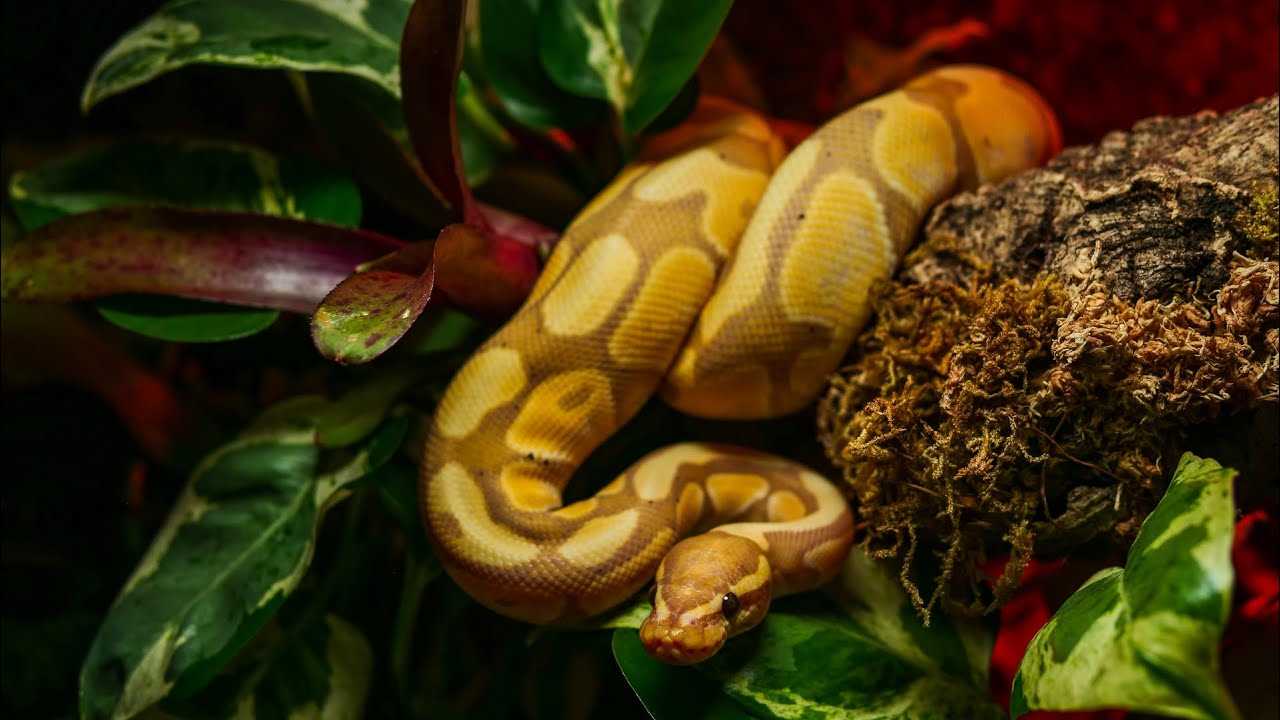
1. Selecting the Right Substrate
The substrate you choose for your ball python’s bioactive enclosure is essential for maintaining the health and well-being of your snake. It should provide a natural and comfortable environment for your python to thrive in. Some suitable substrates for a ball python bioactive enclosure include coconut husk, cypress mulch, and organic topsoil.
2. Choosing the Proper Terrarium Size
Ensure that the terrarium for your ball python is appropriately sized to accommodate its growth and natural behaviors. A larger enclosure will allow for more hiding spots and ample space for your snake to explore. It should be at least 36 inches long, 18 inches wide, and 12 inches tall for an adult ball python.
3. Adding Live Plants
4. Installing Proper Lighting
Ball pythons require a day and night cycle to establish their natural rhythms. Provide proper lighting by using a full-spectrum UVB bulb for 12-14 hours a day and a heat lamp to maintain the appropriate temperature gradient in the enclosure.
5. Maintaining Humidity and Temperature
Consistency in humidity and temperature is crucial for the health and well-being of your ball python. Aim to maintain a humidity level of 50-60% and a temperature gradient of 75-80°F on the cool side and 85-90°F on the warm side of the enclosure. You can achieve this by using a hygrometer and a thermostat.
6. Providing Hiding Spots
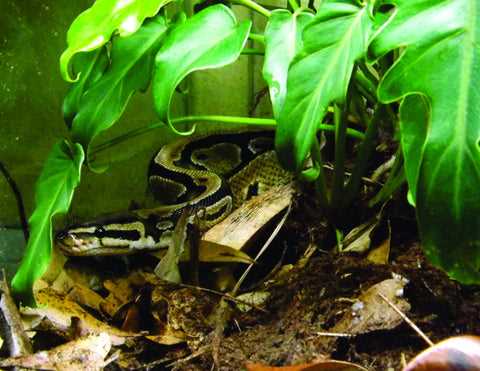
Incorporating multiple hiding spots is vital for your ball python’s sense of security. Place hide boxes or reptile caves on both the cool and warm sides of the enclosure to provide options for your python to regulate its body temperature and feel safe.
7. Feeding and Enrichment
Feeding your ball python in a bioactive enclosure differs slightly from traditional setups. Offer pre-killed or live prey items appropriate for your snake’s size and age. You can also provide enrichment by using puzzle feeders or hiding food items to encourage natural hunting behaviors.
8. Regular Monitoring and Maintenance
Regularly monitor the temperature, humidity, and cleanliness of the bioactive enclosure. Perform spot cleaning and remove any waste or uneaten prey items to maintain a healthy and hygienic environment for your ball python.
Following these guidelines when creating a bioactive enclosure will help ensure the well-being and longevity of your ball python. Remember to research and seek advice from experienced reptile keepers or reptile veterinarians to provide the best care possible for your pet.
Substrate for Ball Python Bioactive Enclosures
Choosing the right substrate for your ball python bioactive enclosure is an important aspect of their care. The substrate not only provides a base for your snake to move on, but it also plays a role in maintaining humidity levels and promoting a healthy environment for your snake and the invertebrates that live in the enclosure.
Best Substrate Options
- Cypress Mulch: Cypress mulch is a popular choice for ball python bioactive enclosures. It holds moisture well and helps maintain humidity levels. It also provides a natural and aesthetically pleasing substrate for your snake to explore.
- Orchid Bark: Orchid bark is a type of chunky bark substrate that is often used in bioactive setups. It provides good drainage, helps maintain humidity, and adds visual appeal to the enclosure.
- Topsoil: Plain topsoil can also be used as a substrate for ball python bioactive enclosures. It is affordable, holds moisture well, and allows for natural burrowing behavior.
Avoid These Substrates
- Sand: Sand is not recommended as a substrate for ball pythons as it can cause impaction if ingested and can be challenging to maintain in a bioactive setup.
- Newspaper: Although newspaper is easy to clean, it does not provide a naturalistic environment for your snake and may not hold humidity well.
Considerations
Remember to regularly monitor the humidity levels and moisture content of the substrate to ensure they are within the appropriate range for your ball python’s needs.
By selecting the right substrate, you can create a comfortable and bioactive environment for your ball python, ensuring their well-being and promoting their natural behaviors.
Live Plants for Ball Python Bioactive Enclosures
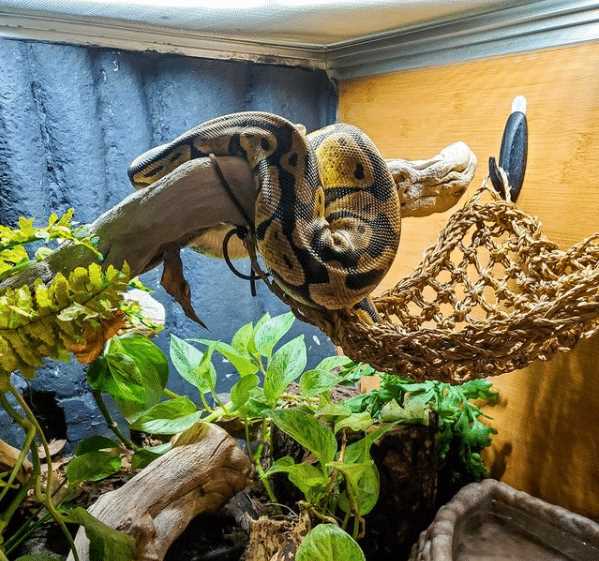
In a bioactive terrarium setup for ball pythons, live plants play a crucial role in creating a natural and enriching environment for the snakes. Not only do they add visual appeal to the enclosure, but they also serve a functional purpose by helping to maintain humidity levels, improving air quality, and providing hiding spots for the snakes. Here are some important points to consider when selecting live plants for a ball python bioactive enclosure:
1. Non-toxic plants: It is essential to choose plants that are non-toxic to ball pythons. Some popular options include snake plants (Sansevieria), pothos (Epipremnum aureum), spider plants (Chlorophytum comosum), and bromeliads (Bromeliaceae family). These plants are safe for ball pythons to interact with and can withstand the conditions of a bioactive terrarium.
2. Low maintenance: When selecting plants, opt for ones that are easy to care for and require minimal maintenance. This is important because ball pythons are not known for their interaction with plants, so choosing low-maintenance options will ensure the plants thrive without much attention. Plants like pothos and snake plants are resilient and can tolerate a range of light and humidity conditions.
4. Varying heights and textures: Including plants of different heights and textures will create a more visually appealing terrarium. This will also provide the ball python with different climbing surfaces and hiding spaces, mimicking their natural habitat. Mix taller plants like snake plants with trailing ones like pothos to create a dynamic layout.
5. Invertebrates in the substrate: Bioactive enclosures rely on a diverse community of invertebrates to help break down waste and maintain a healthy ecosystem. Some common invertebrates that can be added to the substrate include springtails, isopods, and earthworms. These invertebrates naturally control mold and fungus while aiding in nutrient cycling within the enclosure.
Remember to research each plant species individually to determine its specific care requirements and suitability for a ball python bioactive enclosure. Proper plant selection and care will contribute to the overall well-being and enrichment of your ball python’s habitat.
Choosing the Right Lighting for Ball Python Bioactive Enclosures
Care for Ball Pythons:
1. UVB Lighting:
2. Basking Lights:
In addition to UVB lighting, providing a basking light is crucial for ball pythons. Basking lights provide a heat source for your snake to thermoregulate and create a temperature gradient within the enclosure. This allows your python to choose between warmer and cooler areas, mimicking their natural environment. Basking lights can be achieved using halogen bulbs, ceramic heat emitters, or heat mats, depending on your specific setup.
Bioactive Substrate Considerations:
Wrap-up:
Choosing the right lighting for your ball python bioactive enclosure is an important aspect of their overall care. It is crucial to provide UVB lighting to support their vitamin D production and basking lights to create a temperature gradient. Additionally, considering the type of substrate you are using and how it interacts with the lighting is important to maintain the optimal environment for your snake, live plants, and other invertebrates.
By selecting the appropriate lighting for your ball python’s bioactive enclosure, you can ensure that they are receiving the care they need to thrive in a bioactive environment.
Humidity and Temperature Control for Ball Python Bioactive Enclosures
1. Humidity:
Ball pythons are native to tropical regions in Africa, so they require a fairly high level of humidity in their enclosure. The ideal humidity range for ball pythons is between 50-60%, with occasional spikes up to 70% during shedding. To achieve and maintain the appropriate humidity levels, you can take the following steps:
- Use a hygrometer to monitor humidity levels consistently.
- Mist the enclosure with dechlorinated water as needed to increase humidity.
- Provide a large water bowl for your ball python to soak in and increase humidity.
2. Temperature:
Ball pythons are ectothermic, meaning they rely on external sources of heat to regulate their body temperature. Maintaining the proper temperature gradient in the enclosure is crucial for their overall health. Here is a guide to temperature control:
- Provide a temperature gradient ranging from 75-85°F (24-29°C) on the cool side of the enclosure to 88-92°F (31-33°C) on the warm side.
- Use an under-tank heating pad or heat tape to provide belly heat for your ball python.
- Use a thermostat to regulate the temperature of heating elements and prevent overheating.
3. Monitoring and Adjusting:
Regularly monitor the temperature and humidity levels in your ball python’s bioactive enclosure using a reliable thermometer and hygrometer. Make any necessary tweaks to the heating and misting systems to maintain optimal conditions for your snake.
4. Consider the Needs of the Bioactive Environment:
While maintaining the right temperature and humidity levels for your ball python, you also need to consider the needs of the bioactive environment. Some live plants and invertebrates in the enclosure may have specific temperature and humidity requirements. Ensure that the needs of both your snake and the bioactive elements in the terrarium are met.
By carefully managing humidity and temperature levels in your ball python’s bioactive enclosure, you can create a comfortable and healthy environment for your snake. Remember to monitor and adjust these conditions regularly to ensure the well-being of your pet.
Feeding Ball Pythons in a Bioactive Enclosure
Feeding is an essential aspect of ball python care in a bioactive enclosure. Ball pythons are carnivorous reptiles, and their diet mainly consists of small mammals in the wild. However, in a bioactive setup, it is possible to introduce a variety of live invertebrates to provide enrichment and natural feeding opportunities for your python.
Feeding frequency will depend on the age and size of your ball python. Younger snakes may require more frequent feedings, while adult pythons can be fed less frequently. It is generally recommended to feed juvenile ball pythons every 5-7 days and adult pythons every 1-2 weeks. Always monitor your snake’s body condition and adjust their feeding schedule accordingly.
Care and Feeding for Ball Pythons in Bioactive Enclosures
Feeding:
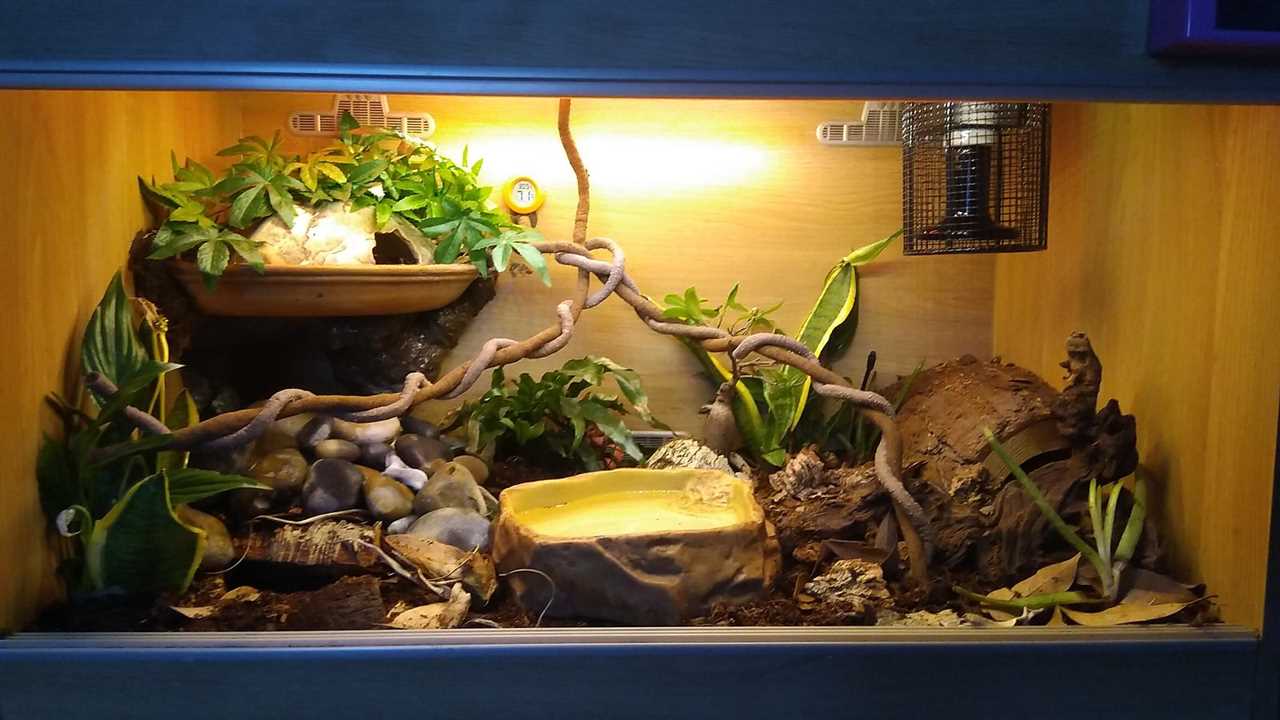
Feeding is an essential aspect of ball python care, and it is no different in a bioactive enclosure. Ball pythons are constrictor snakes and they primarily feed on small mammals such as mice and rats. When providing food for your ball python, it’s crucial to choose the right size prey. Prey items should be no larger than the widest part of the snake’s body to ensure safe swallowing.
Substrate:
The substrate is an essential component of a bioactive enclosure for ball pythons. A suitable substrate should provide moisture and humidity, mimic the natural environment, and facilitate waste decomposition. One popular option for ball python bioactive enclosures is a mix of topsoil and coconut coir, which provides a soft and natural environment for the snake.
Cleaning and Maintenance:
Additionally, it’s crucial to monitor and maintain the overall health and cleanliness of the enclosure. This includes regularly checking temperature and humidity levels, inspecting the live plants for any signs of pests or disease, and ensuring that the lighting and heating elements are functioning properly.
Common Health Issues in Ball Pythons and Their Bioactive Enclosures
1. Respiratory Infections
2. Parasites
Parasites, such as mites or ticks, can also affect ball pythons. These organisms can be introduced into the terrarium through live plants or other invertebrates. Regular monitoring and quarantine of new additions to the enclosure can help prevent the introduction of parasites.
Introducing beneficial invertebrates, such as springtails and isopods, can help control the population of harmful parasites in the enclosure. These beneficial organisms can consume pest insects and keep their numbers in check.
3. Skin Issues
Proper shedding is crucial for the health of ball pythons. In bioactive enclosures, providing a suitable substrate that allows for natural abrasion and proper shedding is important. Substrates like coconut fiber or cypress mulch can provide a textured surface that helps the snake shed its skin without issues.
If a ball python experiences difficulty shedding in a bioactive enclosure, it may be due to inadequate hydration or humidity levels. Providing a humid hide or increasing the overall humidity in the enclosure can help facilitate shedding.
4. Nutritional Deficiencies
Additionally, bioactive enclosures can provide opportunities for the snake to engage in natural behaviors, such as hunting and foraging. These enrichment activities can help prevent boredom and promote overall health and well-being in the snake.
Handling and Enrichment for Ball Pythons in Bioactive Enclosures
Handling and enrichment are important aspects of caring for ball pythons in bioactive enclosures. While ball pythons are generally docile and enjoy being handled, it is essential to provide proper care and handling techniques to ensure the health and well-being of your pet.
When handling a ball python, it is crucial to approach them calmly and confidently. Start by gently placing your hand under their belly and support their body weight. Avoid grabbing or squeezing them as this can cause stress and discomfort. It is also essential to wash your hands before and after handling to prevent the spread of bacteria or other contaminants.
Enrichment is another crucial aspect of caring for ball pythons in bioactive enclosures. Although they are not highly active snakes, providing environmental enrichment can help prevent boredom and promote natural behaviors. One way to enrich their environment is by adding terrarium decorations and hiding spots. These can include logs, branches, rocks, or artificial plants for climbing and exploring.
| Enrichment Tips for Ball Pythons in Bioactive Enclosures |
|---|
| 1. Provide multiple hiding spots throughout the enclosure to allow the snake to feel secure. |
| 2. Use different types of substrates in different areas of the enclosure to create texture and variety. |
| 3. Incorporate invertebrates, such as crickets or mealworms, into the snake’s diet to stimulate hunting and feeding behaviors. |
| 4. Offer a variety of objects for the snake to interact with, such as puzzle feeders or snake-safe toys. |
| 5. Rotate and change the enrichment items regularly to keep the snake engaged and prevent habituation. |
By providing appropriate handling and enrichment, you can ensure that your ball python thrives in its bioactive enclosure and enjoys a stimulating and fulfilling life.
Monitoring and Maintenance of Ball Python Bioactive Enclosures
Monitoring and maintaining a ball python bioactive enclosure is crucial for the health and well-being of your snake. Regular checks and maintenance tasks are necessary to ensure that the enclosure remains clean, safe, and suitable for the python’s needs. Here are some important steps to follow:
1. Regular Inspections
Perform regular inspections of the enclosure to assess the overall condition and identify any potential issues. Look for signs of wear and tear, loose or damaged components, and any signs of pests or disease. Inspect the substrate, plants, and invertebrate populations for any abnormalities.
2. Cleaning and Spot Cleaning
Regularly clean the enclosure to maintain proper hygiene. Spot clean any visible waste or soiled areas in the substrate daily. Every few weeks, conduct a thorough cleaning of the entire enclosure. Remove all items from the enclosure, clean them with a reptile-safe disinfectant, and replace the substrate if needed.
3. Water and Food Dish Maintenance
Regularly clean and replenish the water dish to ensure clean and fresh drinking water for your ball python. Additionally, clean and sanitize the food dish after each feeding to prevent bacterial growth and contamination.
4. Trim Plants and Remove Deceased Invertebrates
Monitor the growth of live plants in the bioactive enclosure and trim them as needed to maintain the desired aesthetics and prevent overcrowding. Remove any deceased invertebrates promptly to prevent decay and maintain the balance of the ecosystem.
5. Temperature and Humidity Monitoring
Regularly monitor the temperature and humidity levels in the enclosure using appropriate thermometers and hygrometers. Make any necessary adjustments to ensure that the conditions remain within the required range for your ball python’s health and comfort.
6. Observing the Snake
Take the time to observe your ball python regularly to monitor its behavior, appetite, and overall health. Look for any signs of stress, illness, or unusual behavior. This can help you identify and address any issues early on.
By following these monitoring and maintenance practices, you can ensure that your ball python bioactive enclosure remains a clean, healthy, and stimulating environment for your snake’s well-being. Regular care and attention are key to providing the best possible care for your ball python.
Troubleshooting common issues in Ball Python Bioactive Care
1. Feeding Issues
- Feeding in a separate, smaller feeding container without substrate or plants
- Using tongs or forceps to present the prey directly to the snake
- Offering a variety of prey items to entice the snake’s interest
2. Maintaining the Terrarium
Keeping a bioactive enclosure clean and well-maintained is crucial for the health of your ball python. If you encounter issues with cleanliness, consider the following:
- Regularly spot cleaning to remove waste and uneaten food
- Monitoring the health of the live plants and replacing any that show signs of decline
- Properly cycling and maintaining the bioactive substrate to prevent odor and bacteria buildup
3. Regulating Humidity and Temperature
Proper humidity and temperature levels are key for the overall well-being of ball pythons. If you are having trouble with humidity or temperature control, try the following:
- Installing a high-quality hygrometer and thermostat to accurately monitor and regulate these parameters
- Adding or adjusting heating and humidity sources such as heat lamps, ceramic heaters, or humidifiers
- Providing a moisture-retaining substrate and misting the enclosure as needed
4. Addressing Health Issues
Even with bioactive care, ball pythons can still experience health issues. If you notice any signs of illness or discomfort, consult a reptile veterinarian who can provide appropriate treatment. Some common health issues in ball pythons include:
- Respiratory infections
- Mites or parasites
- Scale or skin issues
- Digestive problems
- Overweight or underweight conditions
Regular monitoring and attentive care can help prevent and address these health issues effectively.
By implementing these troubleshooting strategies and being proactive in the care of your ball python in a bioactive enclosure, you can ensure that your snake thrives in a healthy and enriching environment.
FAQs about Ball Python Bioactive Care
Q: What type of substrate should I use in a ball python bioactive enclosure?
Q: How often should I clean the bioactive enclosure?
A: Bioactive enclosures are designed to have a self-cleaning system, thanks to the presence of beneficial invertebrates such as springtails and isopods. However, it is still important to conduct regular maintenance checks and remove any waste or uneaten food. A deep cleaning of the enclosure is typically done every few months.
Q: Can I feed live prey to my ball python in a bioactive enclosure?
A: While it is possible to feed live prey to a ball python in a bioactive enclosure, it is generally recommended to feed pre-killed or frozen-thawed prey. This reduces the risk of injury to the snake and eliminates the need for additional care and maintenance of live prey in the enclosure.
Q: Can I use live plants in a ball python bioactive enclosure?
Q: What is the ideal temperature and humidity range for a ball python bioactive enclosure?
A: The temperature range for a ball python bioactive enclosure should be maintained between 75-85 degrees Fahrenheit (24-29 degrees Celsius) during the day and slightly cooler at night. The humidity level should be kept around 50-60%. It is essential to monitor and adjust these conditions regularly to ensure the snake’s well-being.
Q: Are there any common health issues specific to ball pythons in bioactive enclosures?
A: While bioactive enclosures can provide a more natural and enriching environment for ball pythons, there are still some potential health issues to be aware of. These may include respiratory infections, mites, and issues related to humidity and temperature fluctuations. Regular monitoring and proper care can help prevent and address these issues.
Q: How should I handle a ball python in a bioactive enclosure?
Q: Can I introduce other reptiles or animals into a ball python bioactive enclosure?
A: In general, it is not recommended to introduce other reptiles or animals into a ball python bioactive enclosure. Ball pythons are solitary animals, and introducing other species can lead to territorial conflicts and stress. It is best to provide a suitable and comfortable environment solely for the ball python.
Q: How can I troubleshoot common issues in a ball python bioactive enclosure?
A: If you encounter common issues in a ball python bioactive enclosure, such as excessive humidity, odor, or mold growth, there are several troubleshooting steps you can take. These include adjusting ventilation, reducing moisture levels, removing any decaying organic matter, and ensuring proper cleaning and maintenance practices.
Q: Can I use artificial lighting in a ball python bioactive enclosure?
A: While natural sunlight is preferred, artificial lighting can be used in a ball python bioactive enclosure to provide necessary heat and light. UVB lighting may also be beneficial for the snake’s overall health. However, it is crucial to choose the right type of lighting and ensure it is properly set up and maintained.

I’m Lena Adams—a product of an unconventional upbringing in the African wilderness. My father, a daring explorer of African wildlife, sparked my fascination with reptiles, a passion that intertwined with the tragic loss of my mother during an expedition, leaving an indelible mark on my life. Driven to understand the creatures that captivated my parents, I embarked on my journey, sharing insights about reptiles, frogs, and lizards on my website. Through my explorations and conservation efforts, I honour my family’s legacy while seeking connections—to the creatures, nature, and the mother whose presence I yearn to understand.
